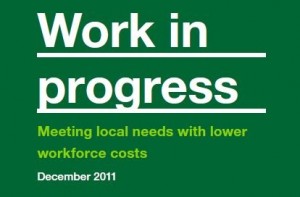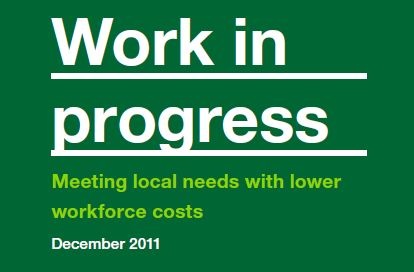The Audit Commission and Local Government Association have jointly launched – Work in progress: Meeting local needs with lower workforce costs. Aimed at councils as employers, the joint report shows how local authorities across England are reducing their workforce costs, with some finding creative solutions.
 |
| [relatedPosts title=”Related Posts”] |
|
|
As government funding for councils shrinks by over a quarter between 2011/12 and 2014/15, councils need to reduce their workforce costs substantially while still providing much needed services. Not all councils face the same financial challenges, but the message is that all must reassess what they do, how they do it, and what their priorities are. Those opting for major restructuring will take more time to realise savings.
Councils are finding ways to cut the pay bill without losing jobs, but redundancies are inevitable the report says. Local government was already reducing posts before the cuts in government funding. In the past year an estimated 145,000 jobs have gone, and this figure will increase in the future. So far many redundancies have been voluntary, but the report warns that compulsory ones are set to rise.
For the report, please click here.
The report is supported by a number of resources including:
Agency workers expenditure tool
The agency workers expenditure tool (Excel, 1.8Mb) shows councils how much they spend on agency workers, compared with groups of similar councils. Councils can choose four groups for comparison: the same government office region; the same type of council; their nearest neighbours (as identified using the model produced by CIPFA’s management support services company, IPF); and those who are in similar labour markets. Councils can identify councils in similar circumstances with lower costs that may be able to share information about their approach.
Workforce expenditure tool
The workforce expenditure tool (Excel, 5.8Mb) shows councils how much they spend on staff as a proportion of their net current expenditure, and how this has changed over time. It allows councils to compare their spending on pay and rewards with other councils. Councils can choose four groups for comparison: the same government office region; the same type of council; their IPF nearest neighbours; and those who are in similar labour markets. It shows how the selected council’s spend compares against the median and upper and lower quartile figures for the chosen comparator group. Councils can then identify councils in similar circumstances with lower costs that may be able to share information about their approach.
Case studies
The 5 case studies provide examples of the different approaches councils are taking to reduce the costs of employing people while protecting valuable services. They show how some councils balance service priorities and financial pressures. These councils do not represent all councils but reflect the range of innovations necessary to manage in tough times. The case studies show what the councils did and why, and the benefits achieved. Each example has contact details for more help and information. For the case studies, please click here.
Briefing for elected members
This briefing for elected members briefing for elected members includes questions designed to help members assess how well their council decides the size, shape and cost of its workforce and how these decisions will affect services and communities. The questions are in two parts: the first deals with the information that should be available to members about the workforce; and the second covers the savings strategies councils could follow in the light of that information. Members should discuss with officers the important aspects of their council’s approach to reducing costs associated with the workforce. For the briefing, please click here.
A guide to pay benchmarking
This document provides practical advice and guidance on how to undertake effective pay benchmarking guidance on how to undertake effective pay benchmarking. It provides a series of steps that practitioners can follow when starting a pay benchmarking process and highlights the main issues that should be considered. For the guide, please click here.
Labour market nearest neighbour methodology
This paper examines the existing ways in which local labour markets are compared (e.g. government regions) and tests these for statistically significant variations in local pay levels. It then tests a series of other variables reflective of local labour market conditions (e.g. house price) and produces a methodology for defining local labour market. This model can then be used to identify local authority areas with similar labour markets. A tool is provided to enable local councils to identify those authorities with similar labour markets. This labour market nearest neighbour methodology will be reviewed and refined with a final model aimed for publication in late 2012. Find the labour market nearest neighbour methodology here
Correction
Please note that paragraph 78 of the report contains an error. The correct text should read: “But the 2010 Local Government Workforce Survey (Ref. 30) suggests that most councils (71 per cent) continue to reward staff through pay progression by annual pay increments (Figure 11).”
Reference 30 in the Appendix should read: “Local Government Association, Local Government Workforce Survey, Local Government Association, 2010.”





